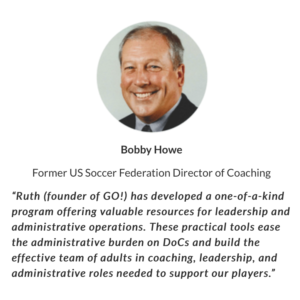New Series on the Landscape of Youth Soccer: Ruth Nicholson Reflects on the State of Youth Soccer
It is time that we look at what is working and what needs to change in our youth soccer world — but, opportunistic sensationalism which generates clicks on social media is not the same as intelligent change.
We want to delve deep into the rocky road and discover the important yet varying perspectives to share with our readers in the hopes of helping bring about a better future for the game in the USA. We have asked coaches and pros — now we thought it was time we asked a specialist in making youth soccer clubs work well.
Here is the next installment of our new series of editorials on soccer and what is right and what is wrong.
Ruth Nicholson is an advocate for organizing organized youth soccer. After working with youth soccer organizations for over 25 years, Nicholson is a systems expert in the areas of operations/administration, funding support, and governance – which means doing a lot of work with volunteer-based soccer programs. A clinician who has presented at more than 11 sessions at NSCAA Conventions/US Youth Soccer Workshops, Nicholson founded GO – Governance & Operations, a go-to expert resource for youth sports governance and operations.
SoccerToday’s Diane Scavuzzo asked Ruth Nicholson on the future of youth soccer in America, specifically on what we need to do differently.
Diane Scavuzzo: What is right and what is wrong in American youth soccer?
Ruth Nicholson: A lot of thought and energy has been directed at coaching education and while there will always be room for improvement here, significantly less energy has been focused on the two other legs of the stool needed to make youth soccer successful.
The often overlooked other sides of the triangle of success are:
- Effective governance and leadership that provides direction and not micro-management of club programs, and
- Efficient operations that make the best use of staff and volunteers to support players and coaches on the field.
The three secrets to a successful club live within the balance and partnership between quality leadership, effective operations, and high-quality coaching and it is the time we emphasize more than just coaching education.
Still breathing should no longer be the criteria to administer soccer in our nation,” says Sam Snow – Technical Director US Youth Soccer.
Sam’s full quote includes “The more education we can do for team managers, tournament directors, club, state and national administrators the better off the game will be,” said Snow.

Diane Scavuzzo: You talk about the 7 Deadly Challenges of a Youth Soccer Club — what are they?
Ruth Nicholson: Finding ways to solve the 7 Deadly Challenges of a Youth Soccer Club is critical to improving youth soccer in the USA.
Here are the 7 Deadly Challenges:
- Not Coaching – Our Director of Coaching has so much administrative work to do that he or she doesn’t have time to work with our coaches and players.
- Deadlock – It takes forever to make a decision or get something done, especially with our committees and board of directors
- Leadership – Our coaches need communication, management, and people skills.
- Overwhelmed – Our team managers and coaches are overwhelmed with administrivia, emails, and phone calls.
- High Turnover — We must recruit and train new volunteers over and over because we have such high turnover.
- Money – We need sponsors, fundraising, and grant dollars so that we can afford to run our club and do not have to charge so much for kids to play.
- Conflict Resolution – Conflicts between coaches, parents, board members and administrators drive good people away from our club.
The point is that we do not fund, train, or support the infrastructure and organizational leadership needed to adequately support our players and coaches, especially at the grassroots level of the game for our youngest players.
Diane Scavuzzo: What is one of the biggest mistakes clubs make?
Ruth Nicholson: We often assume that our youth soccer coaches – paid and volunteer – will pick up the administrative workload which may not be of interest to them or within their skill sets. This can lead to frustration, burnout, conflict, and loss of good coaches.

Diane Scavuzzo: Is there a lot of in-fighting and competition going on in the boardrooms of youth soccer clubs?
Ruth Nicholson: I like to call it the Alpha Dog Syndrome which can cause conflict.
Each of the elements of the Off-Field Team (governance/board members, coaches, and operations/administrators) have specific responsibilities and expertise — and everyone must work together for the good of the game.
When we play out of position, we trigger conflict.
- Board members and club owners are accountable for the overall legal and financial management of the organization
- Coaches are in a position of leadership and power with their teams and within the club. They are the subject matter experts in the game with expertise in how to work with and develop players.
- Operations and administrative staff (including volunteers) manage non-coaching club operations.
- Parents are responsible for their children/players.
The competition belongs on the field between players, not within the Off-Field Team between adult egos and power games.

Diane Scavuzzo: How does it work in successful youth soccer clubs?
Ruth Nicholson: In successful clubs, the members of the Off-Field Team are all respected soccer people with different skills, clear roles, and appropriately integrated responsibilities.
I really hate it when people say “soccer decisions need to be made by soccer people”.
We each see youth soccer through our own perspective/role and often forget to consider, include, or understand the other components (people and their roles) needed to make a high-quality experience for our players.
In our boardrooms and administrative offices, we need to remember that our work is about the players.
If we cannot directly tie what we are doing to benefitting players, teams, or coaches, we should rethink whether or not we should be spending time, money or energy on it!
Diane Scavuzzo: What is working well in youth soccer?
Ruth Nicholson: The things that are going “right” include the emphasis on higher level coaching education focusing on more than just Xs and Os. One great example is the Changing the Game Project.
Programs like the British Columbia Soccer Association’s Club Charter Program are being established to support club operations on and off the field.
Local soccer organizations and leagues are also working to improve their support for member clubs in coaching, governance, and administration through annual training events, such as the Minnesota Youth Soccer Association Winter Symposium.

Diane Scavuzzo: What else do you believe needs to be improved?
Ruth Nicholson: We need to continue to find ways to make coaching education and mentoring accessible and affordable, especially for volunteer coaches, new/younger coaches, and coaches at the grassroots level and our youngest ages.
We need to find ways to better support operations/administrative infrastructure which is often staffed with volunteers. We should invest in training and resources for volunteers and work on creating club cultures which increase trust.
We need to emphasize building a better ‘team’ between coaching and administration – both need each other to be successful and to serve our players. And, it is important to provide regular training and orientation to boards of directors when new members are elected.
The new trend is of reviewing club bylaws, setting/managing expectations, and helping boards understand their roles and responsibilities will lead to a better future for the game of soccer for all youth players.





